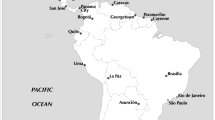Abstract
It is known that there are significant correlations between linking and geographical patterns. Although interlinking patterns have been studied in various contexts, co-inlinking patterns on the Web have only been studied as indicator of business competitive positions. This research studies the use of co-inlinks to local government Web sites, assesses whether co-inlinking follows geographic patterns and investigates reasons for creating the co-inlinks. Strong evidence was found that co-inlinking is more frequent to municipalities in the same functional region than to municipalities in different functional regions, indicating that this geographic aspect influences co-inlinking, even though geographic co-inlinking was not a strong trend overall. Because the functional regions are created based on cooperation between the municipalities, we have indirectly been able to map cooperation from co-inlinking patterns on the Web. The main reason to create co-inlinking links to municipalities was that the source of the links wanted to show a connection to its region.



Similar content being viewed by others
References
Bar-Ilan, J. (2005). What do we know about links and linking? A framework for studying links in academic environments. Information Processing and Management, 41(4), 973–986.
Batagelj, V., & Mrvar, A. (2003). Pajek—analysis and visualization of large networks. In M. Mutzel & P. Jünger (Eds.), Graph drawing software (pp. 77–103). Berlin: Springer.
Björneborn, L., & Ingwersen, P. (2004). Toward a basic framework for webometrics. Journal of the American Society for Information Science and Technology, 55(14), 1216–1227.
Chu, H. (2005). Taxonomy of inlinked Web entities: What does it imply for Webometric research? Library and Information Science Research, 27(1), 8–27.
Hanneman, R. A., & Riddle, M. (2005). Introduction to social network methods. Riverside, CA: University of California. Retrieved January 18, 2009, from http://faculty.ucr.edu/~hanneman/.
Holmberg, K. & Thelwall, M. (2009). Local government web sites in Finland: A geographic and webometric analysis. Scientometrics, 79(1), 157–169.
Kamada, T., & Kawai, S. (1989). An algorithm for drawing general undirected graphs. Information Processing Letters, 31(1), 7–15.
Kim, H. J. (2000). Motivations for hyperlinking in scholarly electronic articles: A quantitative study. Journal of American Society for Information Science, 51(10), 887–899.
Krackhardt, D. (1992). A caveat on the use of the quadratic assignment procedure. Journal of Quantitative Anthropology, 3, 279–296.
Larson, R. (1996). Bibliometrics of the World Wide Web: An exploratory analysis of the intellectual structure of cyberspace. In Proceedings of the 59th annual meeting of the American society for information science (pp. 71–78).
Li, X., Thelwall, M., Musgrove, P., & Wilkinson, D. (2003). The relationship between the WIFs or inlinks of computer science departments in UK and their RAE ratings or research productivities in 2001. Scientometrics, 57(2), 239–255.
Park, H. W. (2003). Examining the determinants of who is hyperlinked to whom: A survey of webmasters in Korea. First Monday, 7(11).
Smith, A., & Thelwall, M. (2002). Web impact factors for Australasian Universities. Scientometrics, 54(1–2), 363–380.
Statistical Regions of Europe. (2006). Nomenclature of territorial units of statistics. Retrieved November 22, 2006, from http://ec.europa.eu/comm/eurostat/ramon/nuts/home_regions_en.html.
Tang, R., & Thelwall, M. (2003). U.S. academic departmental Web-site interlinking in the United States disciplinary differences. Library and Information Science Research, 25, 437–458.
Thelwall, M. (2002). Evidence for the existence of geographic trends in university Web site interlinking. Journal of Documentation, 58, 563–574.
Thelwall, M. (2006). Interpreting social science link analysis research: A theoretical framework. Journal of the American Society for Information Science and Technology, 57(1), 60–68.
Thelwall, M., & Smith, A. (2002). Interlinking between Asia-Pacific University Web sites. Scientometrics, 55(3), 363–376.
Thelwall, M., & Wilkinson, D. (2004). Finding similar academic Web sites with links, bibliometric couplings and colinks. Information Processing and Management, 40(3), 515–526.
Vaughan, L. (2004). Exploring website features for business information. Scientometrics, 61(3), 467–477.
Vaughan, L., Gao, Y., & Kipp, M. (2006). Why are hyperlinks to business Websites created? A content analysis. Scientometrics, 67(2), 291–300.
Vaughan, L., Kipp, M., & Gao, Y. (2007). Why are Websites co-linked? The case of Canadian universities. Scientometrics, 72(1), 81–92.
Vaughan, L., & You, J. (2005, July 24–28). Mapping business competitive positions using Web co-link analysis. In: P. Ingwersen & B. Larsen (Eds.), Proceedings of ISSI 2005—the 10th international conference of the international society for scientometrics and informetrics (pp. 534–543). Sweden: Stockholm.
Vaughan, L., & You, J. (2008). Content assisted web co-link analysis for competitive intelligence. Scientometrics, 77(3), 433–444.
Wilkinson, D., Harries, G., Thelwall, M., & Price, L. (2003). Motivations for academic web site interlinking: Evidence for the Web as a novel source of information on scholarly communication. Journal of Information Science, 29(1), 49–56.
Author information
Authors and Affiliations
Corresponding author
Rights and permissions
About this article
Cite this article
Holmberg, K. Co-inlinking to a municipal Web space: a webometric and content analysis. Scientometrics 83, 851–862 (2010). https://doi.org/10.1007/s11192-009-0148-1
Received:
Published:
Issue Date:
DOI: https://doi.org/10.1007/s11192-009-0148-1




